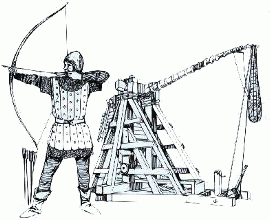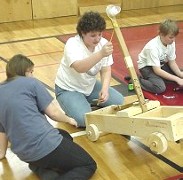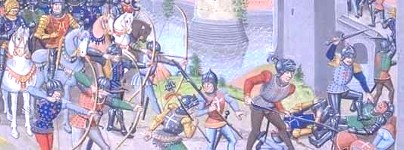

There were many ways of attacking a castle. Here are some of the more popular methods:
- Scaling the walls with tall ladders, especially at night.
- Using a battering ram to knock down the gate or a wall. It had a sharpened end, to break away stones to make a hole in the wall. Its main use, though, was against doors.
- Mining under the wall. Miners dug their way up to the base of the wall, and began removing stones, propping the wall up with wood. When the hole was big enough, they started a fire, which sometimes brought the wall down. Sometimes they would just undermine the corner of a wall or tower, hoping to make it tip over.
- Projectile weapons:
 - Cross-bow:
- Cross-bow:
The cross-bow fired a small arrow with great force, but was a heavy, clumsy weapon, and expensive to make.
- Longbow:
The longbow was made from a single piece of wood, often yew, and a string. It was a very deadly weapon when used properly. For centuries, English armies included thousands of archers, and every youth in the country was expected to become proficient with a bow, in case he had to go to war in the service of his King. An arrow from a longbow could hit its target at hundreds of metres. It could penetrate armour worn by attacking soldiers, and archers could fire arrows as fast as every 6-10 seconds. English longbows helped win several wars for England against vastly larger French armies. In fact, it was the bow which helped make clashes between armour-clad knights on horseback obsolete.
Arrows were seldom carried in a quiver on the back, despite what you've seen in the movies. The quiver was sometimes suspended from the waist, but often the archer just carried his arrows tucked into his belt.
- Ballista:
The ballista was just a huge crossbow, mounted on a platform. Using twisted ropes for storing energy, it fired gigantic arrows which could penetrate several feet of wood. The ballista was more effective as a defensive weapon used by the defenders on the castle walls.
- Siege engines:
Siege engines also threw projectiles, with the aim of knocking down the walls of the castle.
 - Catapult:
- Catapult:
Catapults were used to toss rocks at the walls, or into the castle itself. Often carcasses of dead animals were pitched over as well, to demoralize the inhabitants of the castle. But while powerful, catapults weren't very accurate.
- Trebuchet:
The trebuchet was the successor to the catapult. It worked in a similar way, but used a long lever arm to whip a sling at great speed. The sling propelled a projectile ... usually a large rock, and occasionally a decapitated head, just for effect!
The trebuchet could use heavier rocks, up to 150 kg, and fling them farther, up to 450 metres, with more accuracy. You can see an animation of a trebuchet in action.
- Man to Man Combat:
Eventually the attackers hoped to overrun the walls of the castle, and defeat those within. To do that, they needed many men with swords. By the 13th century, sword metal was hard enough to penetrate a knight's protective armour. Short stabbing daggers were also used, as were axes, clubs, maces, spears, crossbows, and the hand sling.

During the early 1300's , how wars were fought was changed irreversibly with the introduction of gunpowder, which made possible the development of cannons and guns. Originally cannons were designed to fire large arrows, like a ballista, but soon became powerful weapons which could project iron balls weighing as much as 90 kilograms. Over the next hundred years, cannons became more accurate. However, while cannons (and later, hand guns) were widely used, the simpler weapons remained in use until the late Middle Ages. Castles as defensive fortresses lasted until the mid 1600's.
Castles
|



